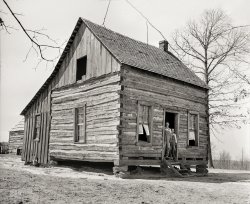
MAY CONTAIN NUTS

Search Shorpy
SHORPY ART

Framed or unframed, desk size to sofa size, printed by us in Arizona and Alabama since 2007. Explore now.
Join and Share
Ad-Free Shorpy
Shorpy is funded by you. Patreon contributors get an ad-free experience.
Learn more.

Recent comments
- Baldwin 62303
- Baldwin VO-1000
- Cold
- No expense spared
- Tough Guys
- Lost in Toyland
- And without gloves
- If I were a blindfolded time traveler
- Smoke Consumer Also Cooks
- Oh that stove!
- Possibly still there?
- What?!?
- $100 Reward
- Freeze Frame
- Texas Flyer wanted
- Just a Year Too Soon
- WWII -- Replacing men with women at the railroad crossing.
- Yes, Icing
- You kids drive me nuts!
- NOT An Easy Job
- I wonder
- Just add window boxes
- Icing Platform?
- Indiana Harbor Belt abides
- Freezing haze
- Corrections (for those who care)
- C&NW at Nelson
- Fallen Flags
- A dangerous job made worse
- Water Stop
Member Photos
The Shorpy
Print Emporium
Print Emporium
Search Shorpy
Search results -- 30 results per page
- Meat Market: 1936
- ... cat and the Joseph D. Frinzi meat market. Photo by Carl Mydans for the Resettlement Administration. View full size.
Nothing To ... until Joe and Pat retired in 1989.
(The Gallery, Carl Mydans, Cats, Kids, Milwaukee, Stores & Markets) ... Posted by Dave - 07/24/2014 - 7:23pm -
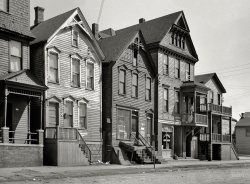
- Waterfront Property: 1935
- ... in shabbiness to exterior." 35mm nitrate negative by Carl Mydans for the Resettlement Administration. View full size.
Definition ... and it was very prone to flooding.
(The Gallery, Carl Mydans, D.C., Kids) ... Posted by Dave - 03/19/2012 - 1:21pm -
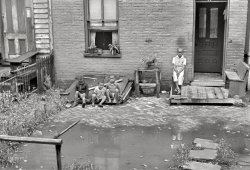
- Eat Red Star Yeast: 1936
- ... View full size. 35mm nitrate negative by Carl Mydans for the FSA.
Eat Yeast? Odd way to word it--you'd think they ... on the hill are still standing.
(The Gallery, Carl Mydans, Milwaukee, Railroads) ... Posted by Dave - 09/08/2011 - 5:13pm -
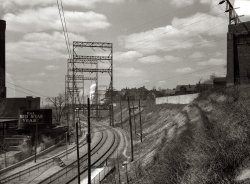
- Behind the Scenes: 1935
- ... Northwest Washington, D.C." Medium format negative by Carl Mydans for the Resettlement Administration. View full size.
Still ... Let's hope he's a good master.
(The Gallery, Carl Mydans, D.C., Dogs) ... Posted by Dave - 06/29/2017 - 1:32am -
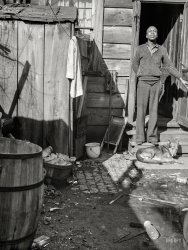
- The Apartment: 1935
- ... of Columbia." One of hundreds of photographs taken by Carl Mydans to document housing conditions in the poorer sections of Washington, ... and pie sat on the sturdy shelf.
(The Gallery, Carl Mydans, D.C., Kitchens etc.) ... Posted by Dave - 09/13/2011 - 10:42pm -
![The Apartment: 1935 July 1935. "Kitchen of an apartment available for rent in the District of Columbia." One of hundreds of photographs taken by Carl Mydans to document housing conditions in the poorer sections of Washington, D.C., during the Depression. 35mm nitrate negative for the Resettlement Administration. View full size.
APARTMENT FOR RENTAdorable D.C. studio apt available downtown. Amenities include charming turn-of-century hardware, gas stove, spacious enamel sink. Quaint period flooring lends provenance to this cozy historic prize. Such potential! 2500/mth, utilities not included. No pets.
Dwelling in the pastMy apartment in the Bronx (1990s) had a built-in just like this. Maybe a little less lopsided than this one, though.
Common bondIt's funny to think that many people in American cities have lived in just such an apartment, even to this day. The place is probably 40 years old in this photo. I've lived in three just like it.
Kitchen archeologyMy NJ apartment in the 1990s looked just like this, too, without the old stove, which was to the distant right of the sink, the whole room being only 4 and half feet wide and 11 feet long. One section of wooden cabinets had been removed to make room for a refrigerator, with a single outlet, and along the wall facing the sink was another, single outlet. Made making toast and coffee at the same time impossible. Not a problem in the 1920's, when mine was built, either, since both would likely have used a stove in that era. The countertop had at least ten layers of oilcloth, wallpaper, contact paper and a top layer of thin plastic that I had to remove at one point before painting it all white. Thought I was being "Modern" - but I guess not!
For Real?That kitchen in Dupont Circle is considered charming and the apartment goes for $3,500 a month.
Clearance issuesUnless it is the focal length playing tricks on me, it would be hazardous to approach the sink while the left burner is on.
[Check the floor. There are four and a half diamonds of space between stove and sink. - Dave]
Speaking of hazardsNewspapers piled atop the burners is a nice touch.
POVIn most of the world today this would be a very luxurious kitchen.
Looks good to meI'm sure the photographer took this shot to illustrate bad housing conditions, but a sink and cabinet almost exactly like that were one of the main selling points for me when I bought my house three years ago -- and I plan to put in a similar linoleum floor.
NYCI lived in a basement apartment in Greenwich Village until 1996. Same sink, much worse cabinetry, slightly better gas stove, linoleum flooring (like the one pictured), only, no windows. Paid $900 a month, and considered myself lucky.
Prolific Carpenters? It seems everyone recognizes that hutch-like cabinet. My Grand-mama had it's twin in her Brooklyn, NY, Brownstone walk-up through the 50's. The stove had been up-graded to white porcelain by then, but many a turkey and pie sat on the sturdy shelf.
(The Gallery, Carl Mydans, D.C., Kitchens etc.)](https://www.shorpy.com/files/images/8a00391a.thumbnail.jpg)
- Old School: 1935
- ... the old schoolhouse. Hamilton County, Ohio." Photo by Carl Mydans, Resettlement Administration. View full size.
Memories of Early ... was it cold and dark in the winter.
(The Gallery, Carl Mydans) ... Posted by Dave - 09/04/2013 - 1:58am -
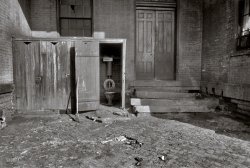
- One Way: 1936
- ... Gashouse District. Medium format nitrate negative by Carl Mydans for the Farm Security Administration. View full size.
This is ... in the vicinity of the '37'.
(The Gallery, Carl Mydans) ... Posted by Dave - 12/07/2015 - 11:51am -
![One Way: 1936 February 1936. "Narrow street in New Brunswick, New Jersey." That part of town known in many American cities as the Gashouse District. Medium format nitrate negative by Carl Mydans for the Farm Security Administration. View full size.
This is Peace StreetThis would be looking down Peace Street, as Eber's was apparently located at 5-7 Peace Street as per the 1937 city directory.
Despite my best efforts to figure out what happened to it, I couldn't figure out where Peace Street was/is, as it apparently was either renamed or obliterated over time.
All Gone NowThis was looking north up Peace Street toward Albany. (Burnet became Peace at the intersection where this was taken.) Most of this came down in the 50's as part of a roadway expansion, and the rest when what became the Hyatt Regency was built in the early 80's. Hard to believe the gashouse lasted until around 1960!
I remember that building!The tan brick affair (well, I know it was tan but of course it's in black and white here) with arched windows at the end of the street is the Public Service Electric and Gas building. I was born in New Brunswick and I remember it, but I don't remember any narrow street like this opening onto Albany Street where the building was. I also don't remember a fuel storage tank, although it certainly stands to reason one should have been there.
I'm sure the other people who posted comments are right - it is Peace St., which I never heard of. There were very few cobblestoned areas in the New Brunswick I remember, mainly the square by the railroad station.
[The "fuel storage tank" is a gas holder, also called a gasometer. - Dave]
Narrow streetsI lived on Neilson Street in the early 50's. The area wasn't much different then. Most building were torn down in the 60's and replaced with restaurants I can't afford to eat in.
Can't help thinkingphotographically speaking that the original Peace Street was much more interesting than its present incarnation. Packed full of character.
Based on historical aerial photosThe large tank came down between 1957 and 1963. The space it occupied is currently the Johnson & Johnson property (the tank was near the current Johnson Drive on the Route 18 side of the property).
Unfortunate ChangeWhat a remarkable change to the area between then and now. It looks like suburbia today, while in the 1930s it was apparently part of the city center. I can imagine all those old buildings restored, renovated, and in use as a trendy touristy area of shops and eateries.
Tough Work If You Can Get ItIt appears they had no problem getting men to shovel snow during those tough Depression years.
1912 Sanborn map Here is a segment from a 1912 fire insurance map showing Peace Street between Albany and Washington Streets. I think the photographer was at the intersection of Church and Peace looking north. I estimate that the gas tower would have been situated in the vicinity of the '37'.
(The Gallery, Carl Mydans)](https://www.shorpy.com/files/images/SHORPY-8b26917a.thumbnail.jpg)
- Boys to Men: 1935
- ... lots of photogenic exertion. 35mm negative by Carl Mydans for the FSA. View full size.
Misinformed I thought they used ... to do with the Seven Seas!
(The Gallery, Carl Mydans) ... Posted by Dave - 04/10/2014 - 2:06pm -
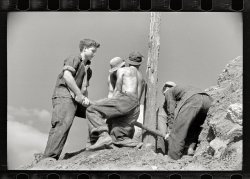
- Gus the Horseshoer: 1936
- ... near the electric railroad." 3x4 nitrate negative by Carl Mydans. View full size.
High Water Would it be possible to get a ... to install indoor plumbing.
(The Gallery, Carl Mydans, Cars, Trucks, Buses, Horses, Milwaukee) ... Posted by Dave - 08/10/2012 - 4:16pm -
![Gus the Horseshoer: 1936 April 1936. Milwaukee, Wisconsin. "Houses at Detroit and Van Buren streets near the electric railroad." 3x4 nitrate negative by Carl Mydans. View full size.
High WaterWould it be possible to get a close up of the water tower on the tannery? I can't make out what it says. The exclamation point indicates that it's very important.
[Well isn't that interesting. "FREE XXXELMANN!" Maybe starting with a T. Who will be the first to solve this Shorpy mystery? - Dave]
Blues Brothers, too!This is essentially where the Blues Brothers "ran off the road" and flipped their old Police Interceptor Dodge. I was in the neighborhood, in college, the day of the filming.
Free ______!"Free Mumia"? Very cutting edge for 1936!
On a more serious note, Detroit Street has been renamed St. Paul Street, and there's not a lotta tanning or shoeing going on there these days.
View Larger Map
Free Thaelmann!Free Ernst Thaelmann?
http://en.wikipedia.org/wiki/Ernst_Th%C3%A4lmann
He was an anti-fascist, anti-Nazi Marxist. He ran against Hitler in '32 for German president. When Ernst lost to Adolph, he tried to organize a general strike and coup against Hitler the next year and when that failed he was jailed by the Gestapo. He died at Buchenwald in August, 1944.
Thaelmann had his 50th birthday in April of '36 and it apparently drew worldwide attention. Milwaukee's large German/Polish immigrant population (except for the Swede, Peterson the Horseshoer) should have made Thaelmann's Nazi imprisonment a local big deal.
First!!!??
The smellsI imagine the folks living between the tannery and horseshoer had very few visitors.
Tachan tachan...Coloreado por Paco.
Colage y acuarela.
Paco!How dare you paint over a priceless and historic photograph. Have you no shame?
Learn something new with every pictureI'm always impressed by Dave and the rest of the Shorpy community. "Free Thaelmann!" seems accurate.
During the Cold War, Ernst Thaelmann became a hero to the USSR, which might be why I hadn't heard of him until today. It's an interesting story, though, as the movement to support him seems to have been supported by a counterculture, complete with controversial demonstrations. To wit, as the Hindenburg prepared to set an endurance record in 1936, "a red biplane flew over the hangar trailing a pennant which read: 'Fight Fascism--Help Free Thaelmann.'" (NYT). NYT also had a 1934 headline, "ANTI-NAZIS BREAK INTO HARVARD YARD" about Thaelmann supporters.
In 1925, Thaelmann had come in a distant third in the German presidential elections (as reported by the Lake Region Times, 4/30/1925).
"Communist Pranksters"From the Milwaukee Journal of October 1, 1939:
Milwaukee progressThanks to the map that JeffK provided I got a better mental picture of this location. Decades ago I did some work at the nearby Milwaukee Tallow Company which helped produce an acrid stench that permeated the neighborhood. I think the building JeffK points toward is the same one as the former Mamie's Grotto located at 625 E. Detroit Street seen here. I grew up in Milwaukee and cannot recall ever hearing of Detroit Street. That is undoubtedly due to it being changed to E. St. Paul Avenue according to the data shown here. With the Horseshoer photo being taken in April 1936, the Chevrolet sedan shown on the left side of the photo was new at the time. It is certainly years newer than the other cars parked on the street which have squared corners on their roofs.
This is Hibernia StreetI found this picture by searching "Milwaukee" on this great site. The caption "houses at Van Buren & Detroit street near the electric railroad" got my attention, as there has never been an "electric railroad" (other than streetcars) anywhere near Van Buren & Detroit Street (now E. St Paul Avenue). The caption on the Milwaukee Journal photo posted by "Nuclear_art" said that the building was near 10th & Clybourn; this made more sense, as the Rapid Transit tracks were on an elevated structure at that point & swung over Hibernia Street. So, it would appear that the photographer is standing at about the line of 9th Street (Gus's address is 902)looking west. This entire area is buried deep beneath the Marquette Interchange today.
Hibernia StreetThe location of this excellent picture is actually about a mile west of the stated location in Milwaukee. We are looking west along Hibernia Street towards Tenth Street. Just out of the picture to the left is the huge freight terminal of the Milwaukee Electric system (later Aldrich Chemical). This building stood until just a few years ago, surrounded by freeway ramps in the middle of the Marquette Interchange. Everything you see in this picture is gone today, the last of Hibernia Street being removed in the early sixties to make way for the freeway.
902 Hibernia / Detroit StreetWright's Directory for Milwaukee in 1888 has a listing for a resident at 902 Hibernia--a news carrier.
The revised version of the Milwaukee Interurban around 1930 planned to be below grade west of Eighth Street. Previously, the interurban used the Clybourn Street streetcar tracks west to 35th Street and turned south a bit, where it entered its own private ROW south of the Marquette Stadium neighborhood and then over a very long trestle over the Menomonee River to connect to its older tracks east of County Stadium/Miller Park around 45th Street and Canal.
However, the Abel and Bach (fancy) luggage factory that took up the space between St Paul and Clybourn at Tenth Street refused to sell its land south of Hibernia for that. [I doubt Abel and Bach was also a tannery, but it could have been. Milwaukee already had plenty of tanneries.]
As to Detroit Street around 1900... That particular street was primarily occupied by Sicilian immigrants back then--with a very high murder rate. This can easily be verified reading through several websites, including those about the Balestreri/Balestrieri family genealogy, among others.
Desilu could have used Detroit Street for an Untouchables episode. Also, that area around Detroit Street was the last in Milwaukee to install indoor plumbing.
(The Gallery, Carl Mydans, Cars, Trucks, Buses, Horses, Milwaukee)](https://www.shorpy.com/files/images/8b28645u.thumbnail.jpg)
- Ashcans on Van Horn: 1935
- ... Street. View full size. 35mm nitrate negative by Carl Mydans.
Judging by the graffiti At least the gangs seem friendly...
... (that stomach is scary)
(The Gallery, Carl Mydans, Cincinnati Photos) ... Posted by Dave - 08/12/2012 - 3:31pm -
![Ashcans on Van Horn: 1935 December 1935. Hamilton County, Ohio. Vicinity of Cincinnati. Dwellings on Van Horn Street. View full size. 35mm nitrate negative by Carl Mydans.
Judging by the graffitiAt least the gangs seem friendly...
666"666" is a medicine for colds and fever? Or a curse?
That's a very vivid picture, though. You can just imagine walking straight ahead, on down the hill.
[Cold medicine. - Dave]
Van Horn StreetYes, sadly, I think so, Dave. This 1838 Bird's Eye Map of Cincinnati shows a Horne Street...but it likely predates Van Horn St, although it's in the general vicinity of Ward 20 (the 1900 census shows Van Horn in Precinct C and D of Ward 20). [Unfortunately, while nicely drawn, the 1900 Bird's Eye Map doesn't seem to include any names for streets, businesses, or points of interest.] The current Google satellite map indicates that there's an expressway about there...and major train tracks.
It also seems that it was possibly in the amazing-looking Price Hill area. Can some locals share insights into Price Hill?
Price HillI can share a bit of insight on Price Hill. Once upon a time was a nicer area, but now it's very rough - poor, violent and rundown. It's on the lower west side of the city, close to the river - a lot of cheap historic housing to be had, if you can stomach the crime and the overall depressed feel to the town.
One of the famed "Seven Hills" in Cincinnati. Inclines were a big thing back in the day.
Price HillAT was a bit harsh on Price Hill. It's really not a poor gang infested slum that AT described. For some reason that's how too many people think of Price Hill. I'm not sure if it's learned from the media or something someone puts together in their own mind.
I'm not aware of a Van Horn St, but from the looks of the photo it could be taken from somewhere in East Price Hill. That's the part of Price Hill closest to downtown Cincinnati. If I had to guess, I would place it around Maryland Ave or near the bottom of Glenway Ave. Considering the street is so narrow and it looks like the the houses are not at street level on the left side, there are only a few places this could be. Maybe I'm not looking at the picture right?
There was a time in Cincinnati when a lot of street names were changed from their German names to more Anglo-Saxon sounding names. Not that Van Horn sounds German, but it's possible the street name no longer exists.
http://pricehillblog.com
Here's a good page of pictures of the historic Price Hill Incline.
And here are some photos I took recently from the other direction (looking down from the top of the hill, where the incline once stood).
Van Horn?I live in Cincinnati and know the town well - however, I've never heard of Van Horn, nor can I find it online. It looks similar to some alleys I've been in, but I can't seem to place any landmarks. Any idea on how I could find it?
[It's probably long gone. A lot of these old neighborhoods and streets disappeared in the slum clearance projects of the 1950s and 60s. You look where they used to be and find expressways and overpasses. - Dave]
Price HillI made the comment on Price Hill. Sure, parts of Price Hill are fine, just like any town. But having worked there (near Considine, across from the police station), I can say with assurance that my viewpoint does not come from the media.
I have to concur with previous poster - this area is quite near the large train yard - on the edge of Price Hill, and was probably swallowed up sometime in the midcentury.
Van HornIf you draw an line from Carr at Dalton Street to Baymiller at Poplar, you might have an idea of the eastern boundary of the Ward/Precinct. Ninth Street was broken up to make room for the highway long ago - you can see a remnant of it if you search for Ninth Street West (9th St W) in 45203 on the map. That would be the southern boundary of the area. I assume Van Horn made up the northern part and the RR tracks the western. What we're looking at here is an area that time forgot - west of downtown/Over the Rhine and east of Price Hill. I don't know what they call that neighborhood now but I think the freeway killed it - not much there right now but a few factories/industries.
Van Horn StreetThanks for the insights, links and pix.
Van Horn is Dutch, and there are some other Dutch named streets/alleys in that vicinity (east of Mill Creek).
The 1900 census shows Van Horn being part of the Ward 20, Precinct C boundary with Ninth, Baymiller and Carr...and part of the Ward 20, Precinct D boundary with Baymiller, Barr, RR, and Carr.
I know Ninth and Baymiller still exist...but haven't seen those others (except the railroad).
666 For Colds & FeversI collect antique bottles, tins and other items and I just so happen to have an actual labeled, corked and sealed bottle of this medicine with the original contents. Yes, it is a strange name for a medicine, but many patent medicines back then had even stranger names as well as ingredients. 666 was made in Minneapolis, MN according to the (bright red and black, no less) label on my bottle. It supposedly cured colds, fevers, ague, catarrh, rheumatism and almost any other malady one could think of. Man, I would absolutely love to have one of those advertising signs for my collection! Another excellent photograph.
~ Boone H
Van Horne AlleyVan Horne Street was in what is now Queensgate. It ran east to west between Seventh and Eighth streets and between Carr and Mound. That area is now completely industrial and there seems to be no trace left of Van Horne Street's existence. I think it was right behind the buildings put up in the 1960's on the south side of what is now West Eighth. In the Hamilton County Auditor's website, a lot of these properties make reference "Vanhorne Alley."
Map here.
Price HillCan you tell me anything about who the Considine was whose name is found in Price Hill streets, Considine Ave, Considine Lane etc? Can you say whether the lower part down by the river and east toward the railroad slot was Irish in the 1870s-1880s? email: ryan90274@yahoo.com (that stomach is scary)
(The Gallery, Carl Mydans, Cincinnati Photos)](https://www.shorpy.com/files/images/8a00715u.thumbnail.jpg)
- Handyman's Special: 1936
- ... Bound Brook, New Jersey." Medium format negative by Carl Mydans for the Resettlement Administration. View full size.
Paint ... grates inside for the coal fire.
(The Gallery, Carl Mydans) ... Posted by Dave - 12/13/2015 - 2:18pm -
![Handyman's Special: 1936 February 1936. "Shabby housing near Bound Brook, New Jersey." Medium format negative by Carl Mydans for the Resettlement Administration. View full size.
PaintWere these houses ever painted?
NEW TO MARKET! 4BR, 2.5 BA Bound Brook fixer-upper $179,900BOUND BROOK - This charming, century-old home is looking for the perfect buyers who aren't afraid to get their hands dirty.
This home with great bones has four bedrooms, one full bath upstairs, a master bedroom ensuite bath and walk-in closet, and a downstairs powder room, large eat-in kitchen, fireplaced living room and formal dining area. The basement is unfinished, and has lots of family room / man cave potential!
Exterior features include period details and trim, wood windows with shutters, gorgeous double front doors, a large covered porch and trellised sun deck. Big yard with lots of landscape opportunities!
Bring your open mind and your tool belt and have a painting party! Home will be sold as-is, no home warranty. Contact Shorpy Real Estate for details, ask for Mr. Higginbotham!
For The Growing FamilyIt appears someone removed the upstairs shutters for the latest update and aluminum siding. With the window curtains and rods already there, a cuboard stocked with cans of beans, and a really nice porch swing this could be a good buy.
A shovel and rake are handy for cleaning up the yard.
The good part is there are no HOA rules in this location and the nearest neighbor is a mile away.
You Can't Judge a Book By It's CoverThe exterior is shabby and in dire need of repair, but my guess is the interior is clean and tidy. Look at the clean, ironed curtains in the windows. The shades are clean too. The shades and curtains are hung straight. Somebody is working to keep it up on the inside.
Still ProudUnmaintained, but this old girl was built with pride and was probably the talk of the town when built. Great trim detail, the roof line we see is still unwavering.
I doubt todays chipboard McMansions will fare as well left unattended.
Didn't I see this place....in "Mr. Smith Builds his Dream House"????
[Or in "Mr. Blandings goes to Washington," perhaps. -tterrace]
The Gothic-arched minature door by the front doorThat little gothic-arched door and frame resting against the wall next to the front door may be a cast-iron coal-burning fireplace front.
There was a time when fireplaces, as opposed to stoves, for coal were built around a cast-iron insert with a door. There were grates inside for the coal fire.
(The Gallery, Carl Mydans)](https://www.shorpy.com/files/images/SHORPY-8b26924a.thumbnail.jpg)
- Washington Water: 1935
- ... series. I wonder if any survive. 35mm negative by Carl Mydans. View full size.
Not such an ancient thing When I was 3 or 4 ... pump was originally below grade.
(The Gallery, Carl Mydans, D.C.) ... Posted by Dave - 09/13/2011 - 10:42pm -
![Washington Water: 1935 July 1935. "Outside water supply, Washington, D.C. Only source of water supply winter and summer for many houses in slum areas. In some places drainage is so poor that surplus water backs up in huge puddles." These municipal water taps (or pumps -- they have crank handles) appear in several photos from this series. I wonder if any survive. 35mm negative by Carl Mydans. View full size.
Not such an ancient thingWhen I was 3 or 4 (in 1961 or 1962) my elderly farmer's wife babysitter in Benton Harbor, Michigan, had only an outside pump like this. And an outhouse, of course. Years later, when we visited them, their kids had moved them into a two storey frame house with indoor plumbing, nearby. Very uptown!
Garden hoseI just really looked at this in full size, and see she's wearing stockings. Good Lord - stockings to go pump some water to wash the dishes after dinner.
Sometimes I think people try so hard it's ... poignant.
They survive!One of the Capitol Hill NE houses my wife and I (unsuccessfully) bid on had one. Red in color (didn't look to see if the paint was original or not), it still works and is now protected in a newer garage. It was one of the great features of the house.
[Fascinating. Was it more like a pump or a faucet? What did the lettering say? I wonder if the crank operated a valve below ground level, as a safeguard against freeze damage. Questions, questions. - Dave]
re: Garden HoseMy grandma wore those. She was a hardworking farm wife and her legs bore the evidence: varicose veins. The stockings (support hose) provided some therapeutic relief and cosmetic peace of mind.
Speculation, but ...I think you nailed it Dave. I bet it also drained back to below grade, whenever it was shut off.
Re: They survive!Because we didn't own the place, we didn't let the water run for longer than a second, but I got the impression that it operated more like a faucet based on the solid flow of water coming out.
If I remember correctly, you moved the handle down and towards you. That moved the faucet head moved down and the water poured out. If you look at the image, you can see how the rectangular plate behind the faucet head is roughly the same size as the piece behind it. (I don't know the proper terminology.) You can see the empty squarish space above the faucet head and imagine how the metal faucet head would slide down to get where it is.
I hadn't thought about freeze damage... we were all just so amazed by this cool piece of history. I can't remember what the pump said. I really wish I had kept the photos I took of it, but when we didn't get the house, I deleted them all.
If you're interested, I can send you the address if you want to drop by and bug the new owner.
Want the one in our yard?We renovated the garage behind our Southeast DC rowhouse last year and removed a non-functioning pump to make room (barely!) for our car. I've held on to the remains, but it may be time to send it to the dump. The lettering is partially illegible, but the word CLIMAX is printed clearly in a semicircle on top with words to the effect "C.M. KEMP MFG. CO. BALTO MD" below. I don't know how it worked, but I can see that about 2 feet of the pump was originally below grade.
(The Gallery, Carl Mydans, D.C.)](https://www.shorpy.com/files/images/8a00366a.thumbnail.jpg)
- Cabin Boys: 1936
- ... in Kentucky." Medium format nitrate negative by Carl Mydans for the Resettlement Administration. View full size.
Love the ... on rocks so termites can't get it.
(The Gallery, Carl Mydans) ... Posted by Dave - 09/09/2016 - 8:15pm -
